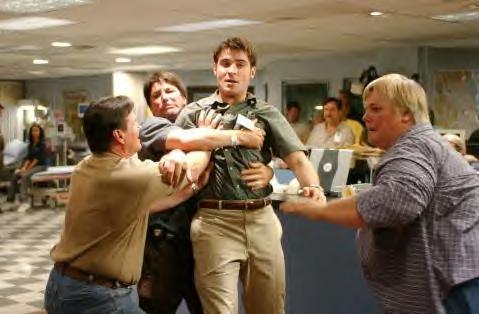ER Finale Braces Public Health Departments
Posted: May 16, 2002 @ 1:15 PM C
Source:
USA
Today
By: Anita Manning
ATLANTA — For scientists trying to develop a plan to prepare for a
bioterrorist attack with smallpox, this week's season finale of the TV
drama ER exemplifies the need for better communication.
In the Thursday night episode, two children come
into the emergency room with fevers. They're treated and sent home with
their parents, who serve in the foreign service. But they soon return to
the ER, this time with poxlike lesions all over their bodies. Smallpox
is suspected, and tissue samples are dispatched to the Centers for
Disease Control and Prevention for testing. If smallpox is confirmed, it
would signal the return of one of the great scourges of all time.
Some public health officials are bracing for the
phone calls to come.
Public health departments should be ready
"to say, no, foreign service families are not at risk, and no,
immigrants are not bringing this here," says George Hardy, director
of the Association of State and Territorial Health Officials.
"We're going to have to be able to respond."
Natalie Smith, chief of the immunization branch
in California's Department of Health Services in Berkeley, says her
department's press office had advance notice of the ER story and
has prepared fact sheets on smallpox and smallpox vaccine to help answer
an anticipated flurry of questions from the press and public.
Last week in Atlanta, Hardy and Smith attended a
meeting of smallpox experts who have been asked by federal health
authorities to investigate strategies to protect Americans against a
potential bioterrorist release of smallpox virus. They'll present a
proposal June 19-20 to the Advisory Committee on Immunization Practices,
which recommends vaccine policy to federal health agencies.
While there seemed no consensus on the risk of a
smallpox attack or on who should be vaccinated, the experts agreed on
one thing: the need for clear, accurate and consistent information that
can be quickly disseminated to a worried public.
So far, communication about smallpox doesn't seem
to be getting through. There is "widespread misunderstanding"
about the disease and the vaccine, even among physicians, says Glen
Nowak of the CDC, who reported results of a study conducted in April.
Researchers interviewed 160 people in focus groups in Philadelphia,
Chicago and San Francisco and conducted in-depth interviews with 17
physicians.
They found that some doctors thought smallpox was
still occurring in the world — the last case was in 1977 — and few
knew much about how to give the vaccine. In the focus groups, many
people thought, erroneously, that smallpox was always fatal (it killed
about 30% of victims).
Knowledge of the dangerous side effects of the
vaccine was spotty in all groups, he says. It is these side effects,
including encephalitis, and a rare, deadly disease called progressive
vaccinia, that concern experts most about any national smallpox vaccine
plan. A recent study by University of Michigan researchers predicts
smallpox vaccine given to Americans ages 1 to 65 would cause 4,600
serious illnesses and 285 deaths.
While smallpox was circulating in the world, the
threat of the disease outweighed the risk of the vaccine. But smallpox
was eradicated more than two decades ago, and no one knows how likely it
is that a terrorist will unleash it again. Stocks of the virus exist in
labs at the CDC and the former Soviet Union, but fears persist that
terrorists have obtained samples.
There's no evidence that there is an increased
risk of a smallpox outbreak, says Michael Osterholm, liaison to the CDC
for Health and Human Services Secretary Tommy Thompson.
"We have to be careful of saying the sky is
falling, and having people question our credibility and suggest we're
overreacting," he says.
"On the other hand, if it does happen and we
didn't prepare, the consequences will be historic."
|